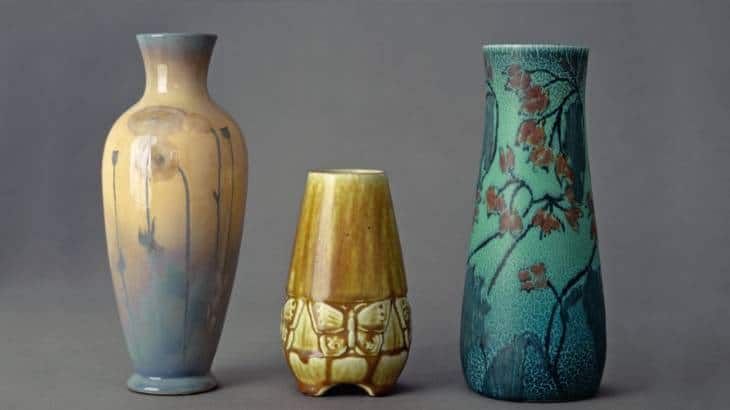Is Rookwood Pottery Still In Business?
Rookwood Pottery was founded in 1880 in Cincinnati, Ohio by pioneering artist Maria Longworth-Nichols. As described on the official Rookwood website, “This company was first founded in 1880 by pioneering artist Maria Longworth-Nichols. She quickly built the company into a world-renowned ceramics studio, focusing on producing high-quality art pottery” (Rookwood – About).
Rookwood became known for its innovative glazes and decorative techniques in the late 1800s. According to Wikipedia, “It was initially located in the downtown Cincinnati area and attracted international recognition for its Art pottery in the late nineteenth and early twentieth centuries” (Rookwood Pottery Company – Wikipedia). The pottery produced at Rookwood was considered very collectible and prized for its artistry and craftsmanship.
Rookwood’s Heyday
Rookwood Pottery was founded in Cincinnati, Ohio in 1880 by Maria Longworth Nichols. It quickly became one of the premier American art pottery companies, known for its innovative glazes and skilled artists [1]. The early 1900s marked the heyday for Rookwood, when it attracted many of the top ceramic artists of the era.
Some of Rookwood’s most notable artists during this time included Carl Schmidt, known for his exceptional modeling skills on vases and statues [2], Kataro Shirayamadani, who excelled at unique crystalline glazes [2], and Sara Sax, acclaimed for her artistic sculpted flora and fauna scenes [2]. The pottery won numerous awards and accolades at expositions, including multiple medals at the St. Louis World’s Fair in 1904.
Rookwood expanded greatly during this period, increasing production and variety of wares. By 1915, Rookwood employed over 300 workers and was firing tens of thousands of pieces annually [3]. The company continued innovating with unique glazes like Iris and Sea Green matte.
Challenges and Decline
Rookwood Pottery faced several challenges in the early 20th century that led to its decline. Increased competition from other American art pottery studios like Weller, Owens, and Roseville cut into Rookwood’s market share. Changes in leadership after the death of founder Maria Longworth Nichols Storer in 1932 also impacted the company. Most significantly, Rookwood struggled financially, especially during the Great Depression.
The rise of other art pottery studios providing similar wares meant Rookwood had more competition for a shrinking consumer base during the economic downturn. To adapt, Rookwood began producing more utilitarian and mass-produced items instead of focusing on artistic ceramics. However, this change diminished Rookwood’s reputation as a leading art pottery producer (https://thepotterywheel.com/the-history-of-rookwood-pottery/). Without Maria Longworth Nichols Storer’s leadership after her death, Rookwood drifted from its founding vision. The company declared bankruptcy in 1941, unable to revive itself after the financial blows of the Great Depression.
Attempted Relaunches
After going through a decline, there have been various efforts to revive the Rookwood Pottery brand over the years. In 2006, the Rookwood name was revived when the brand was purchased by a group of Cincinnati businesspeople who hoped to bring Rookwood Pottery back to prominence.

Led by owner Anthony Petrelli, the revived Rookwood Pottery focused on more modern and conceptual designs compared to Rookwood’s earlier nature-inspired aesthetic. The company brought in artists like Cheryl Warrick, John Parker, and Matthew Adby to create new works. The revived company opened a pottery studio and gallery in the Over-the-Rhine neighborhood of Cincinnati.
The revival saw mixed success [1], and some enthusiasts expressed that the contemporary styles lacked some of the artistry and technical mastery of vintage Rookwood [2]. However, the revival did draw interest and visibility back to the Rookwood name and history in Cincinnati.
Current Status
Rookwood Pottery is currently in business and operating out of its original location in Cincinnati, Ohio. The company was purchased in 2006 by Greg and Katie Weiss and re-opened for production in 2007.[1] Rookwood is now producing new lines of art pottery and architectural tiles while also maintaining production on many classic and vintage shapes and glazes.
The pottery operations are located in the historic Rookwood buildings in the Over-the-Rhine neighborhood of Cincinnati. Guided tours are offered at the pottery, allowing visitors to see artists at work.[2]
In 2021, Rookwood introduced several new glaze colors and shapes to celebrate the company’s 140th anniversary. These new introductions show that Rookwood continues to evolve while respecting its long tradition of artistry and innovation.[3]
Legacy
Rookwood’s legacy as one of the premier American art pottery studios had an enormous impact on the art pottery movement. Founded in 1880, Rookwood was one of the earliest art pottery studios in America and helped pioneer new glazing techniques like matte glazes. According to the Heritage Collection on Rookwood’s website, Rookwood pieces from the early 1900s are now prized museum pieces that represent the height of the American Art Pottery movement.
As one of the leading art pottery studios for decades, Rookwood influenced many other American ceramic artists and potteries. Rookwood perfected the production of matte glazes in the early 1900s, which led to matte glazes becoming popular in the art pottery world. Rookwood also pioneered the technique of multiple clay bodies and glazes used on the same piece to achieve stunning visual effects. Many other studios went on to adopt these innovative techniques in their own work.
Today, Rookwood is acclaimed as one of the most important names in the history of American ceramic art. According to the 1926 Legacy Panel Vase description, Rookwood pieces are housed in major museums like the Smithsonian American Art Museum, the Metropolitan Museum of Art, and the Museum of Fine Arts Boston. Rookwood’s innovations in glazes and production helped shape the American Art Pottery movement and make Cincinnati an important center of ceramic art in the early 20th century.
Notable Collections
Rookwood Pottery is featured in many notable museum collections across the United States. The Cincinnati Art Museum has an extensive collection showcasing the history and artistry of Rookwood Pottery. Major exhibitions have included “Rookwood Pottery: The Glaze of Beauty” in 1990 and “Rookwood Pottery: Shaping the American Taste” in 2021 (https://rookwood.com/collections/rookwood-homage-series-curated-collections).
Other museums with significant Rookwood Pottery holdings include the Metropolitan Museum of Art, Smithsonian American Art Museum, Los Angeles County Museum of Art, and Museum of Fine Arts Houston. Rookwood pieces have fetched high prices at auction, including a vase selling for over $200,000 at a 2004 Christie’s auction (https://rookwood.com/).
Identifying Marks
Rookwood pottery pieces can be identified by the markings found on the bottom. The earliest pieces from around 1880-1886 were simply marked with “Rookwood” in block letters.[1] In 1886, Rookwood started using the iconicRP logo mark consisting of a reversed uppercase R connected to a P. [2]
From 1886 through 1931, Rookwood added decorative flame or feather motifs radiating out from the RP logo to denote the production year. The number of feathers/flames corresponded to the last digit of the year. For example, five feathers indicated it was made in 1895. Sometimes Roman numerals were included as well. In 1932, Rookwood switched to an ink stamp system using letters and numbers to indicate the year.[3]
One way to authenticate vintage Rookwood pieces is to examine the glaze, clay body, colors, and decorators marks, which should match the time period. An expert can also determine authenticity by the style and techniques used. Buyers should beware of modern fakes which mimic the iconic RP logo and flame/feather marks but have other inconsistencies.
Collecting Today
Rookwood pottery remains a popular collectible today for its artistry, historic significance, and rarity of certain pieces. According to Antique-Marks, Rookwood pottery can command high prices at auction, with record sales above $100,000.
There is an active market among collectors seeking quality examples of Rookwood art pottery. Prices vary considerably based on the age, condition, rarity, and artistic merit of individual pieces. Production was limited in the early years, making these pieces more valuable. Certain glazes like Sea Green and Iris are also highly desirable to collectors.
Proper conservation and restoration are important to maintain the value of Rookwood pottery. Chips, cracks, and wear negatively impact value. Professional restoration can stabilize damage but may decrease value for collectors seeking pristine examples. Gentle cleaning is recommended using mild soap and water.
New collectors should learn how to identify authentic Rookwood marks and study signatures of individual Rookwood artists. It is also wise to buy from reputable sellers providing detailed provenance and condition reports. With study, Rookwood continues to offer fulfilling opportunities for collectors of outstanding American art pottery.
Conclusion
In summary, Rookwood Pottery has undergone many changes since its founding in 1880, moving from a thriving business to near collapse and back again. While no longer the dominant force it once was, Rookwood continues operating today producing high-quality ceramic pieces. The brand maintains relevance due to its historic legacy and place in the American Arts and Crafts movement. Its distinctive glazes and innovative production techniques solidified its significance.
Though the company struggled through ownership changes, relocations, and competition, its perseverance allowed it to weather difficult periods. Enthusiasts still collect vintage Rookwood wares, studying marks to date pieces and verify authenticity. The company focuses sales through limited retail partners and its Ohio factory.
Given its rich history and ongoing operations, Rookwood secures its status as an important American pottery studio. Its continued production preserves traditional techniques and innovative glazes for future generations. While unlikely to regain its former prominence, Rookwood persists as a respected name in ceramic arts.




